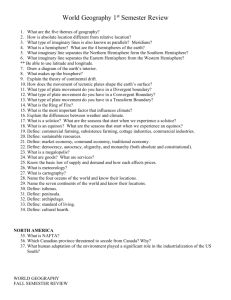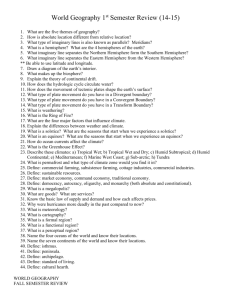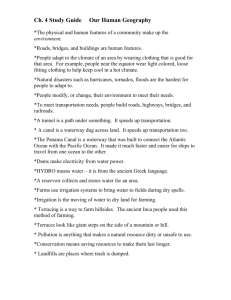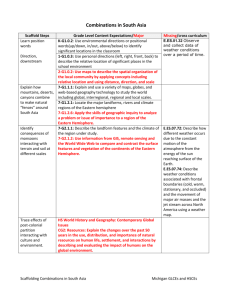World Geography 1st Semester Review
advertisement
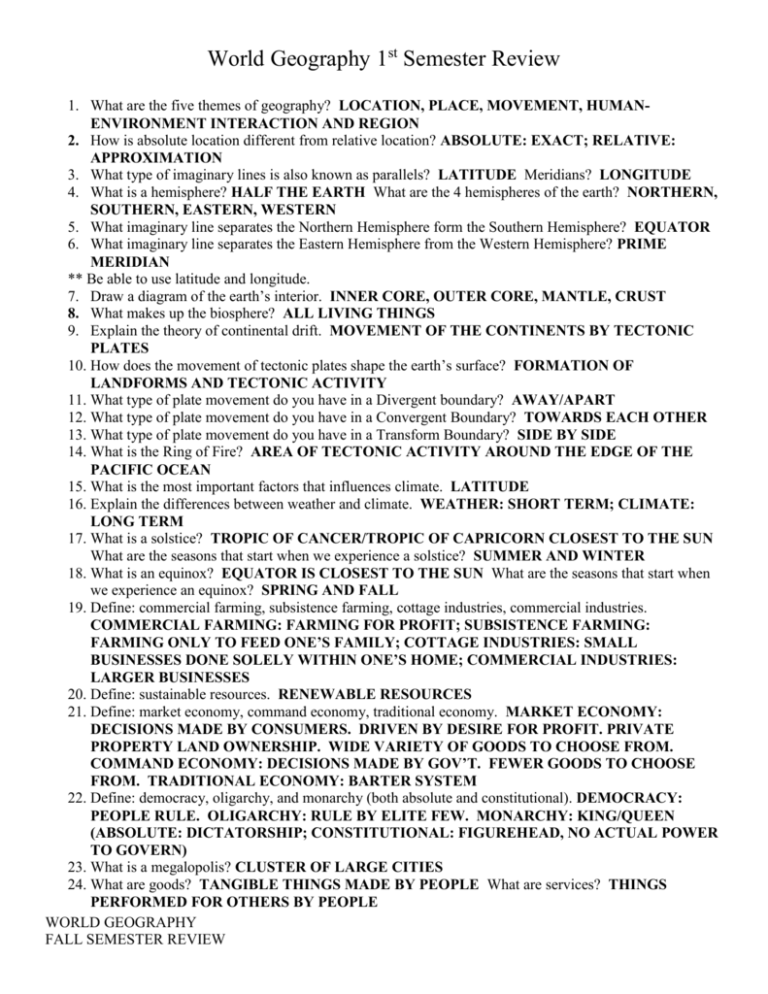
World Geography 1st Semester Review 1. What are the five themes of geography? LOCATION, PLACE, MOVEMENT, HUMANENVIRONMENT INTERACTION AND REGION 2. How is absolute location different from relative location? ABSOLUTE: EXACT; RELATIVE: APPROXIMATION 3. What type of imaginary lines is also known as parallels? LATITUDE Meridians? LONGITUDE 4. What is a hemisphere? HALF THE EARTH What are the 4 hemispheres of the earth? NORTHERN, SOUTHERN, EASTERN, WESTERN 5. What imaginary line separates the Northern Hemisphere form the Southern Hemisphere? EQUATOR 6. What imaginary line separates the Eastern Hemisphere from the Western Hemisphere? PRIME MERIDIAN ** Be able to use latitude and longitude. 7. Draw a diagram of the earth’s interior. INNER CORE, OUTER CORE, MANTLE, CRUST 8. What makes up the biosphere? ALL LIVING THINGS 9. Explain the theory of continental drift. MOVEMENT OF THE CONTINENTS BY TECTONIC PLATES 10. How does the movement of tectonic plates shape the earth’s surface? FORMATION OF LANDFORMS AND TECTONIC ACTIVITY 11. What type of plate movement do you have in a Divergent boundary? AWAY/APART 12. What type of plate movement do you have in a Convergent Boundary? TOWARDS EACH OTHER 13. What type of plate movement do you have in a Transform Boundary? SIDE BY SIDE 14. What is the Ring of Fire? AREA OF TECTONIC ACTIVITY AROUND THE EDGE OF THE PACIFIC OCEAN 15. What is the most important factors that influences climate. LATITUDE 16. Explain the differences between weather and climate. WEATHER: SHORT TERM; CLIMATE: LONG TERM 17. What is a solstice? TROPIC OF CANCER/TROPIC OF CAPRICORN CLOSEST TO THE SUN What are the seasons that start when we experience a solstice? SUMMER AND WINTER 18. What is an equinox? EQUATOR IS CLOSEST TO THE SUN What are the seasons that start when we experience an equinox? SPRING AND FALL 19. Define: commercial farming, subsistence farming, cottage industries, commercial industries. COMMERCIAL FARMING: FARMING FOR PROFIT; SUBSISTENCE FARMING: FARMING ONLY TO FEED ONE’S FAMILY; COTTAGE INDUSTRIES: SMALL BUSINESSES DONE SOLELY WITHIN ONE’S HOME; COMMERCIAL INDUSTRIES: LARGER BUSINESSES 20. Define: sustainable resources. RENEWABLE RESOURCES 21. Define: market economy, command economy, traditional economy. MARKET ECONOMY: DECISIONS MADE BY CONSUMERS. DRIVEN BY DESIRE FOR PROFIT. PRIVATE PROPERTY LAND OWNERSHIP. WIDE VARIETY OF GOODS TO CHOOSE FROM. COMMAND ECONOMY: DECISIONS MADE BY GOV’T. FEWER GOODS TO CHOOSE FROM. TRADITIONAL ECONOMY: BARTER SYSTEM 22. Define: democracy, oligarchy, and monarchy (both absolute and constitutional). DEMOCRACY: PEOPLE RULE. OLIGARCHY: RULE BY ELITE FEW. MONARCHY: KING/QUEEN (ABSOLUTE: DICTATORSHIP; CONSTITUTIONAL: FIGUREHEAD, NO ACTUAL POWER TO GOVERN) 23. What is a megalopolis? CLUSTER OF LARGE CITIES 24. What are goods? TANGIBLE THINGS MADE BY PEOPLE What are services? THINGS PERFORMED FOR OTHERS BY PEOPLE WORLD GEOGRAPHY FALL SEMESTER REVIEW 25. Know the basic law of supply and demand and how each affects prices. DEMAND INCREASES/DECREASES: PRICE INCREASES/DECREASES – SUPPLY INCREASES/DECREASES: PRICE DECREASES/INCREASES 26. What is meteorology? STUDY OF WEATHER 27. What is cartography? STUDY OF MAPS/MAPMAKING 28. Name the four oceans of the world and know their locations. 29. Name the seven continents of the world and know their locations. 30. Define: isthmus. NARROW STRIP OF LAND THAT CONNECTS TWO LARGER AREAS OF LAND 31. Define: peninsula. LANDFORM SURROUNDED BY WATER ON THREE SIDES 32. Define: archipelago. GROUP OF ISLANDS 33. Define: standard of living. QUALITY AND QUANTITY OF GOODS AND SERVICES THAT ARE DISTRIBUTED THROUGHOUT A COUNTRY 34. Define: cultural hearth. SOURCE PLACE FROM WHICH A NEW IDEA COMES NORTH AMERICA 35. What is NAFTA? NORTH AMERICAN FREE TRADE AGREEMENT – MEMBERS: USA, CANADA AND MEXICO 36. Which Canadian province threatened to secede from Canada? QUEBEC Why? TO PRESERVE THEIR FRENCH CULTURE/ HERITAGE 37. What human adaptation of the environment played a significant role in the industrialization of the US South? AIR CONDITIONING 38. Draw a picture of the Columbian Exchange & explain its importance. North America Corn, turkey, potatoes, cacao, tobacco Europe Livestock, disease, sugar, grains, fruits, slaves The exchange shows how goods, ideas, and epidemics moved from continent to continent through trade. 39. What are the three branches of the US government and what does each do? Executive- carries out laws Legislative- enacts laws Judicial- interprets laws 40. What type of economy does the US use? Explain. The US is a free enterprise economy. Private individuals own most of the resources and forms of production. There is little interference by the government. 41. What makes the US such a culturally diverse country? The US was founded as a country of immigrants & has allowed immigrants throughout its history. With these new peoples come different cultures & ideas. Latin America 42. Why is Spanish the native language in so many Latin American countries? MOST WERE COLONIZED BY SPAIN WORLD GEOGRAPHY FALL SEMESTER REVIEW 43. Why is the Amazon Basin of importance to the world? How is it changing? The Amazon River flows more water than any other river in the world. The habitat around it is vast and diverse. It is ecologically important to the entire world. It provides the basis for medicines, habitat for countless species of animals, and helps to control global climate. Deforestation is robbing the area of its valuable resources. 44. How do the following things affect the environment: slash & burn farming, terraced farming? Slash & burn- simple farming method that destroys rain forests and depletes the soil. Terraced farming- step like cuts made into the sides of mountains to allow for farmland. Can lead to erosion. 45. What is the difference between push & pull factors in migration? Push- something draws individuals to an area (jobs, climate, etc…) Pull- something forces individuals from and area (war, famine, pollution, etc…) 46. Why is the Panama Canal so important to world trade? The canal links the Atlantic & Pacific Oceans, therefore it links the economies of the world. 47. What are biodiversity, deforestation and global warming? Biodiversity- area with a wide range of plant and animal species. Deforestation- cutting & clearing of trees in the rain forests. May lead to global warming. Global warming- increase in global temperatures that effects global weather patterns. Latin America Map Mexico, Cuba, Panama, Colombia, Chile, Argentina, Brazil, Venezuela, Gulf of Mexico, Caribbean Sea, Atlantic Ocean, Pacific Ocean, Strait of Magellan, Cape Horn, Tierra del Fuego, Lake Maracaibo, Lake Nicaragua, Lake Titicaca, Bolivia, Paraguay, Honduras, Guatemala, Panama Canal, Andes Mountains, Sierra Madre Occidental, Sierra Madre Oriental, Sierra Madre del Sur, Yucatan Peninsula, Baja California, U.S., Amazon River, Angel Falls, Puerto Rico, Bahamas, Jamaica World Map Africa, Asia, Australia, Europe, North America, South America, Antarctica, Arctic Ocean, Atlantic Ocean, Pacific Ocean, Indian Ocean, Tropic of Cancer, Tropic of Capricorn, equator, Prime Meridian, Arctic Circle, Antarctic Circle WORLD GEOGRAPHY FALL SEMESTER REVIEW
